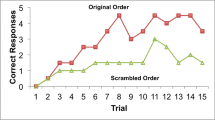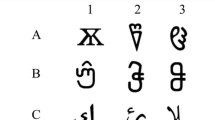Abstract
The production of 3-item probe sequences by 20 adults was assessed after the participants were trained to respond to three 3-item sequences (A1→A2→A3, B1→B2→B3, and C1→C2→C3). Each sequence was learned progressively according to the successive phase method (1-item phase, 2-item phase, and then 3-item phase). Performance on the 3 probe sequences was consistent with the formation of classes of mutually substitutable sequence stimuli. Elsewhere, learning of these functional classes was enhanced when subjects were trained with a 5-min compared to a 24-hr intersessions delay. These results were discussed according to experimental conditions and acquisition of learning rules knowledge.
Similar content being viewed by others
References
D’AMATO, M. R., & Colombo, M. (1988). Representation of serial order in monkeys (Cebus apella). Journal of Experimental Psychology: Animal Behavior Processes, 14, 131–139.
GREEN, G., SIGURDADOTTIR, Z. G., & SAUNDERS, R. R. (1991). The role of instructions in the transfer of ordinal functions through equivalence classes. Journal of the Experimental Analysis of Behavior, 55, 287–304.
GREEN, G., STROMER, R., & MACKAY, H. A. (1993). Relational learning in stimulus sequences. The Psychological Record, 43, 599–616.
HOLCOMB, W. L., STROMER, R., & MACKAY, H. A. (1997). Transitivity and emergent sequence performances in young children. Journal of Experimental Child Psychology, 65, 96–124.
LAZAR, R. (1977). Extending sequence-class membership with matching to sample. Journal of the Experimental Analysis of Behavior, 27, 381–392.
MACKAY, H. A., STODDARD, L. T., & SPENCER, T. J. (1989). Symbols and meaning classes: Multiple sequence production and the emergence of ordinal stimulus classes. Experimental Analysis of Human Behavior Bulletin, 7, 16–17.
MAYDAK, M., STROMER, R., MACKAY, H. A., & STODDARD, L. T. (1995). Stimulus classes in matching to sample and sequence production: The emergence of numeric relations. Research in Developmental Disabilities, 16(3), 179–204.
SIGURDADOTTIR, Z. G., GREEN, G., & SAUNDERS, R. R. (1990). Equivalence classes generated by sequence training. Journal of the Experimental Analysis of Behavior, 53, 47–63.
STEVENS, S. S. (1951). Mathematics, measurement, and psychophysics. In S. S. Stevens (Ed.), Handbook of experimental psychology (pp. 1–49). New York: John Wiley.
STRAUB, R. O., SEIDENBERG, M. S., BEVER, T. G., & TERRACE, H. S. (1979). Serial learning in the pigeon. Journal of the Experimental Analysis of Behavior, 32, 137–148.
STRAUB, R. O., & TERRACE, H. S. (1981). Generalization of serial learning in the pigeon. Animal Learning and Behavior, 9, 454–468.
STROMER, R., & MACKAY, H. A. (1993). Human sequential behavior: Relations among stimuli, class formation, and derived sequences. The Psychological Record, 43, 107–131.
STROMER, R., MACKAY, H. A., COHEN, M., & STODDARD, L. T. (1993). Sequence learning in individuals with behavioural limitations. Journal of Intellectual Disability Research, 37, 243–261.
TERRACE, H. S. (1986). A nonverbal organism’s knowledge of ordinal position in a serial learning task. Journal of Experimental Psychology: Animal Behavior Processes, 12, 203–214.
Author information
Authors and Affiliations
Rights and permissions
About this article
Cite this article
Galy, E., Camps, JF. & Melan, C. Sequence Class Formation Following Learning of Short Sequences. Psychol Rec 53, 635–645 (2003). https://doi.org/10.1007/BF03395457
Published:
Issue Date:
DOI: https://doi.org/10.1007/BF03395457




